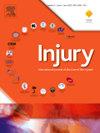Does the timing of debridement of an upper extremity open fracture really matter?
IF 2.2
3区 医学
Q3 CRITICAL CARE MEDICINE
Injury-International Journal of the Care of the Injured
Pub Date : 2025-03-24
DOI:10.1016/j.injury.2025.112300
引用次数: 0
Abstract
History
– A 49yo woman was involved in a car crash. She suffered an isolated, open, left both bones forearm mid-diaphyseal fracture. She had a sling applied at the scene but had a 16-hour transport time from an isolated rural location. She was found to have no other injuries upon her careful work-up at the Level 1 emergency department. The injury had not compromised the distal neurovascular status of the limb. The ER staff admitted the patient to the orthopedic team. The patient had an evaluation by a senior resident and their assessment was that this was a grade 3A open fracture of the dorsum of the mid forearm (Figure 1 and Figure 2). By the time surgery could be initiated at the Trauma center, fully 36 hours had passed. Most of the delay at the Trauma center was due to other very significant injuries in the Trauma room that day.
Past Medical History and Social History
– She is a married woman and lives with her husband and a university aged teenager. She has been a nonsmoker. She has no medical problems that she sees a physician about. She works as a secretary but presently is unemployed. She has only had obstetrical surgery, has no allergies and takes no medications. She is a regular wine drinker.
求助全文
约1分钟内获得全文
求助全文
来源期刊
CiteScore
4.00
自引率
8.00%
发文量
699
审稿时长
96 days
期刊介绍:
Injury was founded in 1969 and is an international journal dealing with all aspects of trauma care and accident surgery. Our primary aim is to facilitate the exchange of ideas, techniques and information among all members of the trauma team.

 求助内容:
求助内容: 应助结果提醒方式:
应助结果提醒方式:


